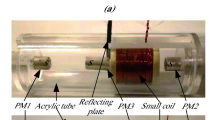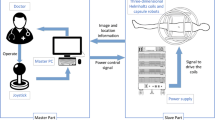Abstract
Much research on the development of a robotic capsule and micro robot for the diagnosis of gastrointestinal diseases has been carried out. The powering of these micro systems is becoming very challenging as the implementation of such systems is limited due to the existence of on-board power supplies. This paper presents a micro robotic system based on magnetic principles. The goal is to build a system in which a capsule-robot can be manipulated wirelessly inside an enclosed environment such as human’s body. A prototype of capsule-robot is built and tested, that can be remotely operated with three DOF in an enclosed environment by transferring magnetic energy and electromagnetic waves. A magnetic drive unit generates magnetic energy for the manipulation. Experimental results show the capsule-robot is manipulated and moved through a desired trajectory in a viscous fluid. The capsule-robot can be potentially used for endoscopy and colonoscopy.












Similar content being viewed by others
References
Bruinewoud H (2005) Ultrasound-induced drug release from polymer matrices. PhD thesis, Technische Universiteit Eindhoven
Craig D, Khamesee MB (2007) Motion control of a large gap magnetic suspension system for microrobotic manipulation. J Phys D: Appl Phys 40(11):3277
Gregersen H (2003) Biomechanics of the gastrointestinal tract: new perspectives in motility research and diagnostics. Springer, London
Khamesee MB, Kato N, Nomura Y, Nakamura T (2002) Design and control of a microrobotic system using magnetic levitation. IEEE/ASME Trans Mechatronics 7(1):1–14
Li H, Tan J, Zhang M (2009) Dynamics modeling and analysis of a swimming microrobot for controlled drug delivery. IEEE Trans Autom Sci Eng 6(2):220–227 ID 1
Mehrtash M, Shameli E, Khamesee MB (2010) Magnetic telemanipulation device with mass uncertainty: modeling, simulation and testing. Int J Appl Electromagnet Mech 34(4):211–223
Moglia A, Menciassi A, Schurr M, Dario P (2007) Wireless capsule endoscopy: from diagnostic devices to multipurpose robotic systems. Biomed Microdevices 9(2):235–243
Oldenburg CM, Borglin SE, Moridis GJ (2000) Numerical simulation of ferrofluid flow for subsurface environmental engineering applications. Transp Porous Med 38(3):319–344
Park H, Park S, Yoon E, Kim B, Park J, Park S (2007) Paddling based microrobot for capsule endoscopes. In: IEEE international conference on robotics and automation, 2007, pp 3377–3382
Rosensweig RE (1997) Ferrohydrodynamics. Dover, Mineola
Voltairas PA, Fotiadis DI, Michalis LK (2002) Hydrodynamics of magnetic drug targeting. J Biomech 35(6):813–821
Acknowledgments
The authors gratefully acknowledge the Canada Foundation for Innovation (CFI) and the Natural Science and Engineering Research Council of Canada (NSERC) for financial support.
Author information
Authors and Affiliations
Corresponding author
Rights and permissions
About this article
Cite this article
Hosseini, S., Mehrtash, M. & Khamesee, M.B. Design, fabrication and control of a magnetic capsule-robot for the human esophagus. Microsyst Technol 17, 1145–1152 (2011). https://doi.org/10.1007/s00542-011-1231-0
Received:
Accepted:
Published:
Issue Date:
DOI: https://doi.org/10.1007/s00542-011-1231-0




